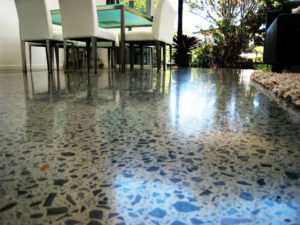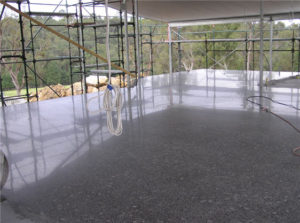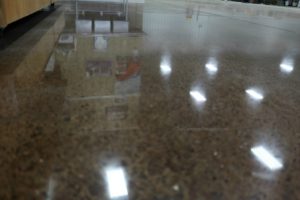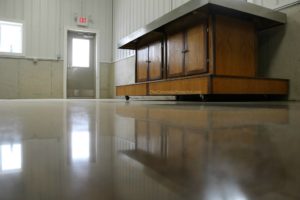By David Stephenson
Over the last few months, I’ve had multiple projects with issues related to polished concrete color repairs. I feel it will benefit Concrete Decor readers to understand the process for corrections as well as some simple tips and tricks for achieving desired results.
As a consultant, one of the things I enjoy is helping and training contractors. I’m satisfied when I feel I have taught something new to a contractor or field crew that will impact the quality of their future work. In this article, I’ll talk about several different issues illustrated with project photos. I hope you get as much benefit from reading this article as I have gotten by writing it.
Always Expect Residue with Color Repairs
The first issue I want to discuss is residue. When applying the dye, there’ll be residue every single time. This isn’t something that happens if you put way too much color down but is inherent in the application process because no two concrete slabs are exactly alike. Every concrete slab has a different amount of porosity which affects the amount of liquid that can be absorbed into its surface.
Dye 101
Because of this, all dye or coloring products are over-engineered to make sure that slabs of all varieties can be colored. As a manufacturer, you assume dilution rates of your color to meet the demands of the most porous surface. Then you add about 10 to 15 percent more color. As a contractor, this just means you’ll have residue on every project. Sometimes you’ll have more than others based on… you guessed it; the porosity or the slab.
Polished concrete color repairs equal residue and is something to be considered on every project.
It needs to be removed or it can cause issues on issues. The easiest removal method involves an auto-scrubber with pads (not brushes). Dye residue is easy to see because the pattern visible on the surface looks speckled and spotted.
When you’re moving across the floor, the reflected light will almost have a metallic look in areas of excessive residue. Wiping the floor with a damp cloth will reveal if there’s substantial residue remaining or not.
Each application of color will leave a residue.
If you’re applying multiple coats of color, there’s no need to remove the residue in between, but it’s important to remove excess residue before you continue polishing. If you don’t, the dye particulates will build upon your resin diamonds.
As the diamonds heat up from friction, a small cluster of dye particles will melt into their surface. Additional particles will then be caught up until you get what’s called an “ember.” This ball of hardened dye particulates will cause major scratches in the surface of your polished concrete floor and damage the diamonds so that they’re unusable.
Ember scratches are very difficult because they’re usually deep enough that you must drop back several steps in the grinding process to get them out. These scratches had to be removed with a 150-grit metal-bond diamond, which added significant work and time to the project.
The residue from polished concrete color repairs is easy to remove with water and a scrubber.
If you don’t have an auto-scrubber, you can use a swing buffer with water and a soft pad. Then you can squeegee and shop vac up the water with the residue suspended in it. I’ve found polished concrete cleaner removes residue best because it holds the particulates in suspension better than water alone. You need some liquid or the residue won’t come loose from the slab’s surface.
As a side note, here’s a tip.
When doing multiple colors next to each other, always do the darker color first. After you’ve dyed the darker color successfully, clean the residue well along the edge of the color transition. The paper and tape the edge of the already-applied color and apply your densifier to the colored area.
A densifier will help keep any additional color from bleeding into the lighter colored area.
There is no feeling worse than having a perfect color application with red and blue next to each other and then going to clean the floor and having the edge of both colors turn purple because of residue transfer. Cleaning and specifically densifying the darker color first will help with this issue.
Regarding color:
The mistake I see contractors make repeatedly is not removing the residue and then stain protecting over the top of the remaining residue on the floor.
Since the residue isn’t bonded to the concrete, it acts as a bond breaker by holding the stain protection off the surface. With cleaning and traffic, the stain protection? as well as the color residue? will come off in spots, creating unattractive dull spots and a headache for the customer. If there’s too much stain protection over the top of dye residue, with a few cleanings you’ll get dull spots where the residue and stain protection came off.
Resolve color issues first!
One extremely important thing: Don’t apply stain protection to a floor unless all color issues have been resolved.
When you apply the stain protection, it acts as a microscopic sealer. This is great for keeping liquids out, including an additional color that may be needed for blending or repair purposes. After you’ve stain-protected a floor, it’s extremely difficult to correct anything or make any repairs.
There are basically two options for repairs after stain protection has been applied.
The first is to regrind the floor to get below the sealer application. This usually requires a transitional grind if not a metal bond. Basically, you must redo about 75 percent of your work. The second option and the one I recommend more often is to use a chemical to remove the stain protection.
AmeriPolish has a stain protection stripper is one that I recommend because it doesn’t damage the color that’s in the concrete. The clear product will chemically remove the stain protection, as well as any dye residue on the surface.
Note the color of the liquid stripper.
The brown dye residue you see is the result of the stain protection removal process. The standard application of dye is still in the concrete and this is the residue that should have been removed before the stain protection was applied.
After chemical removal, the floor can be repolished or, in rare cases, just burnished and then stain protection can be reapplied. No matter what repair you need to make, the stain protection must be removed. It is much, much easier to perform repairs or get additional color in if you do the work before a sealer is applied.
Applying more and blending colors
Among the many repairs that can be done, the two most common are applying more color and blending colors. Sometimes concrete takes color differently in areas. This is usually a result of how the concrete was troweled when it was placed and how tight the surface’s paste is. The tighter the pore structure, the harder it is to get color into the floor.
With a standard application, these tighter areas just don’t take as much color, resulting in a lighter appearance in spots. Additional color can be added just by applying more coats but this doesn’t always do the trick.
Most color manufacturers offer some version of penetrating agents.
These chemicals are designed to keep the color in liquid suspension on the floor longer so that more color can be carried into the concrete pore structure. I’ve found solvent-based dyes generally penetrate better because the liquid molecule structure is smaller in solvents than water.
The downside to solvents is that they evaporate faster than water. Penetrating agents are specific solvents engineered to remain liquid longer, allowing more color particulates to penetrate the surface.
If a project is complete, including stain protection, the typical repair would go something like this:
Chemically strip stain protection, scrub the floor to neutralize the stripper and carry dye, sealer and stripper residues off the surface. Reapply color in its standard form or use manufacturer-recommended dye and penetrating agent mixtures to darken the floor’s color. Scrub to remove dye residue, burnish to remove any water or scrubber marks, reapply stain protection and burnish per manufacturer’s recommendations.
If you are adding color, don’t stop your application at a distinct line. The darker color will be extremely obvious if you do. It is much better to fade the color application to nothing over a random area. The natural shading and variation of the concrete will make the blend virtually invisible.
Blending at cold pour joints
Another extremely common issue is blending at “cold pour” joints, which are joints where different pours meet. For various reasons, a concrete slab can be broken into several different pours. These pours can be different colors due to cement, sand, aggregate, admixtures, age since placement, curing methods or how they were finished. There’s an endless variety of reasons why concrete pours can be different colors. There isn’t much affect overall of these varying shades except right at the point of transition. The lighter or darker shade is extremely noticeable where the slabs meet.
Often the responsibility for blending these slabs becomes the decorative contractor’s issue.
The dye is an extremely forgiving product to work with but most contractors are scared to try blending colors. This issue is easiest to deal with before applying the main color. I usually recommend using a heavily diluted black to darken the lighter concrete along the edge and let the darker color fade out to nothing 10-15 feet away from the joint.
As an example, let’s assume you’re using a chocolate brown dye. I recommend using a 20 percent strength black dye along the lighter pour edge to darken the concrete base before applying the brown dye.
With the diluted black, it’s easy to apply light coats until the base colors are a closer match. When the gray concrete is close shade-wise, apply the brown color evenly across the entire area. If the color transition is not stark and clearly defined with straight edges, most customers won’t notice it.
The fading color doesn’t draw the eyes.
The issue is a little bit more difficult when a color has already been applied. You must look closely at the color variation and determine what additional color is needed to get the finish closer. I always recommend using darker colors and diluting them so you can apply light coats until you have a close match.
As an example, let’s refer to the cold pour photo.
I looked at the light brown color of the lighter pour and felt that a black, even diluted, would be too dark. So, we stripped the stain protection and protected the darker side of the joint. Then we used a 20 percent strength walnut dye and lightly sprayed the joint, fading the spray out about 10 feet back. The first application was still too light so we applied a second coat of the diluted walnut color. The result, while not 100 percent perfect, is now an extremely close match?
After scrubbing to remove any residue, we stain-protected and burnished the area. What was a large issue for the customer is now a minor color change where the two concrete pours meet. The customer was happy with the work since the stark color change didn’t stand out any longer.
Takeaways for all
There are several things to take away from this article.
- Always remove dye residue before additional polishing or applying a stain protection product.
- If an additional color is needed, try using the manufacturer-approved penetrating agents. They will help get more color into the floor.
- Check each area closely prior to applying a stain protection product. It’s simpler to conduct repairs before stain protection has been applied.
- Always try to chemically remove stain protection rather than grind it off. There is much less work and a better overall product with a chemical strip.
- Straight lines or stark transitions are much more noticeable than randomly fading out color from repairs.
- When trying to blend darker and lighter colors, use light coats of diluted dye to match the colors as closely as possible. Remove all residue from the surface before continuing your polish or applying stain protection.
David Stephenson owns Polished Concrete Consultants, based in Dallas, Texas. As a consultant, he offers decorative concrete programs for retailers and troubleshooting for a wide range of clients. Contact him at david@polishedconsultants.com.



